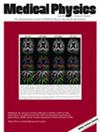Spectral performance for iodine quantification of a dual-source, dual-kV photon counting detector CT
Abstract
Background
Multi-energy CT (MECT) enables quantification of material concentrations by measuring linear attenuation coefficient line integrals with multiple x-ray spectra. Photon counting detector (PCD)-CT utilizes a detector-based approach for MECT that can suffer from substantial spectral overlap, resulting in amplified material quantification noise. Dual-source dual-kV approaches for MECT are currently utilized in some energy-integrating detector (EID)-CT systems and can potentially be utilized with PCD-CT for improved spectral separation.
Purpose
To evaluate the iodine quantification performance of a novel dual-source (DS)-PCD-CT scan mode and compare to single-source (SS)-PCD-CT and DS-EID-CT.
Materials and Methods
A 30 cm × 40 cm solid water phantom with four iodine inserts (2, 5, 10, and 15 mg/mL) was scanned with the three spectral modalities: SS-PCD-CT with two energy thresholds, DS-PCD-CT (90/Sn150 kV), and DS-EID-CT (90/Sn150 kV). For each modality, full-dose (12 mGy) and half-dose scans were acquired, and images were reconstructed with filtered back-projection using a quantitative (Qr40) kernel. When scanning in a DS configuration, the total radiation dose budget is split between two detectors, increasing the strength of a signal-dependent filter compared to a SS acquisition. To account for this effect, the modulation transfer function (MTF) for each modality was measured from a 0.05 mm tungsten wire. A linear spatial filter was applied to the SS images to match their MTF to that of the DS images. The resulting high- and low-energy images were input into an image-domain least squares material decomposition algorithm with iodine and water as the two basis materials. Iodine quantification accuracy and noise measured from the iodine basis images were used as figures of merit, and t-tests used to compare between modalities.
Results
The 10% MTF cutoffs were 0.56, 0.57, 0.60, and 0.57 lp/mm for DS-EID-CT, DS-PCD-CT, SS-PCD-CT, and SS-PCD-CT after MTF-matching, respectively, with the SS-PCD-CT MTF cutoff dropping to 0.58 lp/mm at half-dose. Without accounting for the signal-dependent filter by matching the MTFs, the noise in iodine material basis images from SS-PCD-CT was 10% higher than that of DS-EID-CT. After matching the MTFs, the noise in the SS-PCD-CT iodine image was 9%–22% lower than that of the DS-EID-CT. The lowest iodine image noise was from the DS-PCD-CT, which was 39%–41% lower than the DS-EID-CT. The DS-PCD-CT noise magnitude was significantly different from the other modalities. Mean iodine quantification accuracy across all measured concentrations was within 5% for all modalities at full dose, but was only below 5% for the DS-PCD-CT at half-dose.
Conclusions
SS-PCD-CT with two energy thresholds outperformed DS-EID-CT in terms of image noise in iodine basis images when spatial resolution was matched. DS-PCD-CT gave the lowest noise due to the combination of PCD technology and improved spectral separation from the different x-ray spectra.

 求助内容:
求助内容: 应助结果提醒方式:
应助结果提醒方式:


